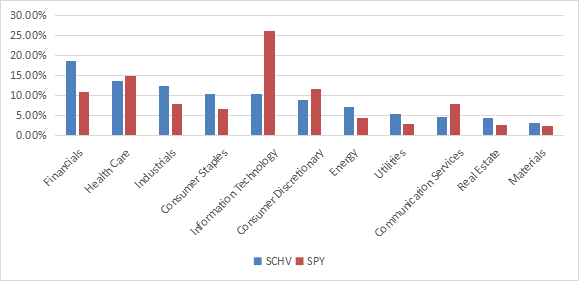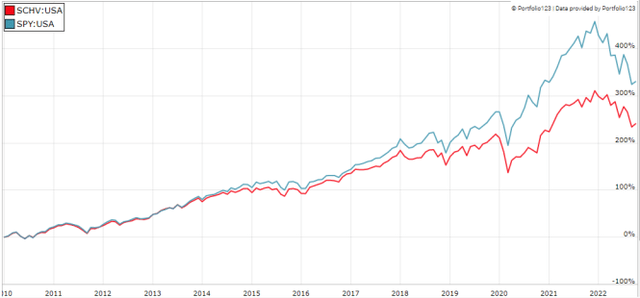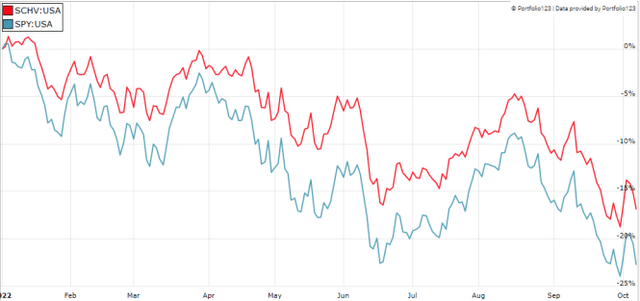vaeenma/iStock via Getty Images
This article series aims at evaluating exchange-traded funds (“ETFs”) regarding the relative past performance of their strategies and quality of their current portfolios. As holdings and their weights change over time, updated reviews are posted when necessary.
Schwab U.S. Dividend Equity ETF strategy and portfolio
The Schwab U.S. Dividend Equity ETF (NYSEARCA:SCHV) has been tracking the Dow Jones U.S. Large-Cap Value Total Stock Market Index since 12/11/2009. It has 513 holdings, a distribution yield of 2.29% and an expense ratio of 0.04%.
As described on S&P Dow Jones Indices website, the three main value factors used in the index constitution are the Projected Price-to-Earnings Ratio, the Price-to-Book Ratio, and the dividend yield. It is weighted by float-adjusted market capitalization, rebalanced quarterly, and reconstituted annually.
The fund has a low annual turnover: 8.10% for the most recent fiscal year. It invests almost exclusively in U.S.-based companies (99%), mostly in large and mega caps (73%), and to a lesser extent in mid-caps (26%). Despite the fund’s name, there are a few small cap constituents, but their weight is insignificant (less than 1%).
The heaviest sector is financials (19%), followed by healthcare, industrials, consumer staples and technology (each in a 10% to 14% range). Other sectors are below 9% individually and 34% together. SCHV is much less overweight in the top sector than the S&P 500 (SPY), which has 26% of asset value in technology. Compared to SPY, SCHV overweights financials, industrials, consumer staples, energy, real estate, utilities, energy and materials. It underweights mostly technology, communication and consumer discretionary.
SCHV sectors (Chart: author, data: Fidelity)
As expected, SCHV is cheaper than SPY regarding valuation ratios:
|
SCHV |
SPY |
|
|
Price/Earnings TTM |
14.24 |
17.97 |
|
Price/Book |
2.34 |
3.38 |
|
Price/Sales |
1.64 |
2.18 |
|
Price/Cash Flow |
10.85 |
13.65 |
The 15 holdings with a weight above 1% are listed below with fundamental metrics. They represent 23.6% of asset value. They are all under 3%, so risks related to individual companies are low. As a reference, the largest holding of SPY (Apple Inc.) represents almost 7% of the fund’s value.
|
Ticker |
Name |
Weight% |
EPS growth %TTM |
P/E TTM |
P/E fwd |
Yield% |
|
Berkshire Hathaway, Inc. |
2.74 |
-88.96 |
53.67 |
19.47 |
0 |
|
|
Johnson & Johnson |
2.34 |
3.44 |
23.29 |
15.88 |
2.82 |
|
|
Exxon Mobil Corp. |
2.34 |
393.29 |
11.04 |
7.85 |
3.48 |
|
|
JPMorgan Chase & Co. |
1.74 |
-16.90 |
8.51 |
9.50 |
3.77 |
|
|
Procter & Gamble Co. |
1.66 |
5.61 |
21.42 |
21.14 |
2.94 |
|
|
The Home Depot, Inc. |
1.64 |
14.47 |
17.47 |
17.14 |
2.67 |
|
|
Chevron Corp. |
1.60 |
703.62 |
10.69 |
8.65 |
3.55 |
|
|
AbbVie, Inc. |
1.36 |
90.35 |
19.64 |
10.02 |
4.06 |
|
|
Pfizer Inc. |
1.33 |
118.65 |
8.29 |
6.51 |
3.78 |
|
|
PepsiCo, Inc. |
1.23 |
12.39 |
24.32 |
24.17 |
2.85 |
|
|
Merck & Co., Inc. |
1.22 |
198.27 |
13.41 |
11.85 |
3.15 |
|
|
Bank of America Corp. |
1.21 |
6.92 |
9.60 |
9.71 |
2.86 |
|
|
The Coca-Cola Co. |
1.18 |
17.92 |
24.78 |
22.14 |
3.23 |
|
|
Walmart, Inc. |
1.03 |
41.18 |
25.66 |
21.97 |
1.74 |
|
|
The Walt Disney Co. |
1.00 |
181.64 |
56.46 |
25.26 |
0 |
Quality
In previous articles, I have shown how three factors may help cut the risk in a portfolio: Return on Assets, Piotroski F-score, and Altman Z-score. In my ETF reviews, risky holdings are companies with at least 2 red flags among: bad Piotroski score, negative ROA, unsustainable payout ratio, bad or dubious Altman Z-score, excluding financials and real estate where these metrics are less reliable.
About 3% of asset value is in risky stocks regarding these criteria (I did the calculation with holdings weighing more than 0.1%). My usual aggregate quality metrics are very close to the benchmark (see next table).
|
SCHV |
SPY |
|
|
Altman Z-score |
2.9 |
3.3 |
|
Piotroski F-score |
6.1 |
5.9 |
|
ROA% TTM |
8.11 |
7.49 |
SCHV ETF Performance
Since January 2010, SCHV has lagged the S&P 500 by 1.9 percentage point in annualized return.
|
Total Return |
Annual Return |
Drawdown |
Sharpe ratio |
Volatility |
|
|
SCHV |
231.18% |
9.83% |
-34.90% |
0.7 |
14.29% |
|
SPY |
311.76% |
11.72% |
-32.05% |
0.81 |
14.75% |
SCHV vs. SPY since 2010 (Portfolio123)
SCHV has been on par with SPY from 2010 to 2014, then it started underperforming the benchmark. However, it has been more resilient in 2022 (next chart).
SCHV vs. SPY in 2022 (Portfolio123)
Comparing SCHV with my Dashboard List model
The Dashboard List is a list of 80 stocks in the S&P 1500 index (occasionally less), updated every month based on a simple quantitative methodology. All stocks in the Dashboard List are cheaper than their respective industry median in Price/Earnings, Price/Sales and Price/Free Cash Flow. After this filter, the 10 companies with the highest Return on Equity in every sector are kept in the list. Some sectors are grouped together: Energy with Materials, Telecom with Technology. Real Estate is excluded because these valuation metrics don’t work well in this sector. I have been updating the Dashboard List every month on Seeking Alpha since December 2015, first in free-access articles, then in Quantitative Risk & Value.
The next table compares SCHV performance since inception with the Dashboard List model, with a tweak: here the Dashboard List is rebalanced quarterly to make it comparable with a passive index.
|
Total Return |
Annual.Return |
Drawdown |
Sharpe ratio |
Volatility |
|
|
SCHV |
231.18% |
9.83% |
-34.90% |
0.7 |
14.29% |
|
Dashboard List (quarterly) |
350.83% |
12.51% |
-41.68% |
0.73 |
17.76% |
Past performance is not a guarantee of future returns. Data Source: Portfolio123
The Dashboard List clearly beats SCHV. However, the ETF performance is real and the model performance is hypothetical.
Methodological concerns
In my opinion, ranking stocks in the whole universe regardless of sectors and industries is a methodological issue. Valuation ratios are not comparable across all sectors: you can read my monthly dashboard here about this topic. SCHV overweights financials because valuation metrics are naturally much cheaper in this sector. Unfortunately, they are also much less reliable. The Financial Select Sector SPDR ETF (XLF) has a price-to-earnings ratio of 12.15 and a price-to-book of 1.38. This is a big bias. Such implementation of the value style also disadvantages sectors with large intangible assets that are not correctly reflected by valuation ratios: cutting-edge R&D, strong branding, large user databases for example. They are especially important in technology, consumer discretionary and communication (all underweight in SCHV).
Another concern about the strategy (and most value indexes) comes from using the price/book ratio (P/B) as a main factor. Speaking probabilities, a large group of companies with low P/B contains a higher percentage of value traps than a same-size group with low price/earnings, price/sales or price/free cash flow. Statistically, such a group will also have a higher volatility and deeper drawdowns in price. The next table shows the return and risk metrics of the cheapest quarter of the S&P 500 (i.e. 125 stocks) measured in price/book, price/earnings, price/sales and price/free cash flow. The sets are reconstituted annually between 1/1/1999 and 1/1/2022 with elements in equal weight.
|
Annual Return |
Drawdown |
Sharpe ratio |
Volatility |
|
|
Cheapest quarter in P/B |
9.95% |
-72.36% |
0.48 |
21.05% |
|
Cheapest quarter in P/E |
11.25% |
-65.09% |
0.57 |
18.91% |
|
Cheapest quarter in P/S |
12.62% |
-65.66% |
0.6 |
20.46% |
|
Cheapest quarter in P/FCF |
12.23% |
-63.55% |
0.61 |
19.05% |
Data calculated with Portfolio123
This explains my choice of using P/FCF and not P/B in the Dashboard List model.
Takeaway
SCHV implements a value-oriented strategy in a large and mid-cap universe, using a ranking system based on three metrics. It has lagged SPY since its inception, but has been more resilient in the 2022 market downturn. It is cheap in management fee and in valuation ratios. Quality metrics are similar to the benchmark. Price history mostly covers a growth-oriented bull market. SCHV may do better in a period more favorable to value investing. Independently of the growth/value paradigm, I see two issues in its methodology: stocks are ranked regardless of their sectors, and the price-to-book ratio is a factor adding some risk. I think an efficient value model should compare stocks in comparable sets (sector or industry), like I do in the Dashboard List. This model also uses three valuation metrics, but prefers price/free cash flow to price/book and adds a simple profitability factor to filter out some value traps and normalize the number of components.


Be the first to comment